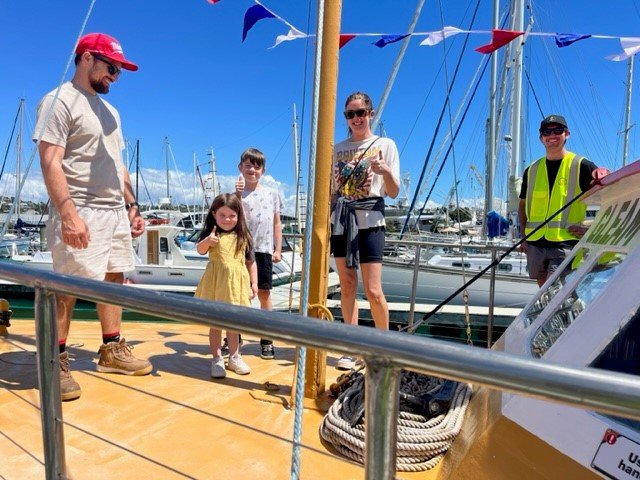Gleam shines on in new educational tour role
One of Nelson’s oldest and most graceful fishing and work boats has a new lease of life.
The nearly 80-year-old Gleam was a mainstay of the local inshore fleet. It fished for many of the species you find in fish and chip shops – such as gurnard, john dory, red cod, rig – and is thought to have had more scallops, oysters and mussels across its decks than any other vessel. It was fished by the Guard family for many years until being deregistered as a fishing vessel about nine years ago.
Darren Guard inherited Gleam from his father, Phil. While it was tied up in Nelson Haven racking up maintenance costs, he wondered how to extend its life. The answer was The Gleam Team Trust, set up to promote the seafood industry and the local marine economy.
The refurbished and resurveyed Gleam now takes visitors on free education tours of the harbour and out through the Cut into Tasman Bay throughout the summer.
On Seafood Saturday, 9 March, Gleam will be moored and open to the public from 9am–12pm. Head down to Berth F08 at the Nelson Marina (past Ruby’s Espresso) for a special chance to climb aboard and learn more about this historic vessel and how it worked as a fishing boat, feeding the community with tasty kaimoana.
Around 150 members of the public were able to tour the moored Gleam in November last year as part of the Nelson Marine Safety Expo, with Darren saying it was a real hit with the kids.
“Everyone was so enthusiastic, asking lots of questions about the fishing industry. Of all the boats people could visit on the day, Gleam was definitely the most popular. I am looking forward to seeing even more families on board Gleam on Seafood Saturday.”
Although celebrated boat builder Jack Guard completed over 100 fishing and work boats and had one of his vessels in pretty much every port, Gleam was not one of his. The vessel was originally built for J. J. Ewing, branch manager for Atlantic Union Oil Co in Wellington, by A. J. Morgan in Picton and launched on 1 November 1946. But Jack admired its lines and purchased it in the mid-1950s for the family, then living at Te Pukatea Bay at French Pass.
Jack was horrified when his elder sons, Chris and John, later took a chainsaw to its aft superstructure to create more space for trawling and dredging. However, that practical approach did not alter its appeal or its performance.
While Gleam is now a grand old lady, her bones are even more ancient. Hardwood was in short supply in the war years and the stringers inside the hull were shaped from timber salvaged from a century-old church.
The vessel operated in local waters in a number of roles, including ferrying passengers, farming equipment, freight, mail, materials for the Farewell Spit lighthouse build, at sea burials and, predominantly, fishing. The wheelhouse also served as a meeting house for fishermen at the end of long days dredging for shellfish.
In its latest chapter, the Gleam Team Tours provides a unique insight into the history of Port Nelson and the importance of the fishing industry and supporting business. Tours are supported by sponsors, including fuel, maintenance, survey and wages, and can take up to 12 passengers, with two crew. For more information about going on a tour, visit: www.guardsafety.co.nz/gleam-team
An earlier version of this story first ran in the August 2022 issue of Seafood Magazine.


